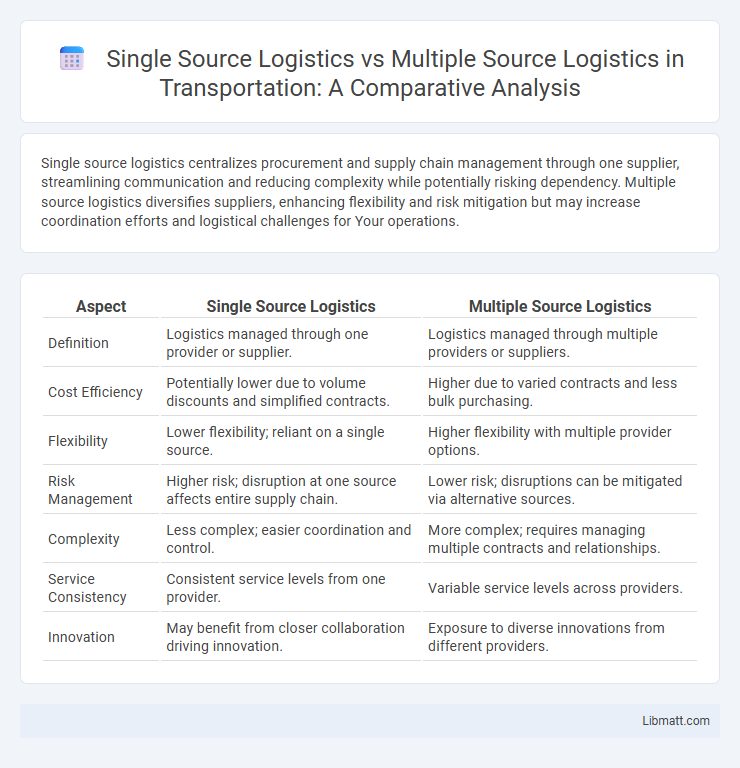Single source logistics centralizes procurement and supply chain management through one supplier, streamlining communication and reducing complexity while potentially risking dependency. Multiple source logistics diversifies suppliers, enhancing flexibility and risk mitigation but may increase coordination efforts and logistical challenges for Your operations.
Table of Comparison
| Aspect | Single Source Logistics | Multiple Source Logistics |
|---|---|---|
| Definition | Logistics managed through one provider or supplier. | Logistics managed through multiple providers or suppliers. |
| Cost Efficiency | Potentially lower due to volume discounts and simplified contracts. | Higher due to varied contracts and less bulk purchasing. |
| Flexibility | Lower flexibility; reliant on a single source. | Higher flexibility with multiple provider options. |
| Risk Management | Higher risk; disruption at one source affects entire supply chain. | Lower risk; disruptions can be mitigated via alternative sources. |
| Complexity | Less complex; easier coordination and control. | More complex; requires managing multiple contracts and relationships. |
| Service Consistency | Consistent service levels from one provider. | Variable service levels across providers. |
| Innovation | May benefit from closer collaboration driving innovation. | Exposure to diverse innovations from different providers. |
Introduction to Single Source vs Multiple Source Logistics
Single source logistics consolidates procurement and supply management through one primary supplier, enhancing consistency, simplifying communication, and reducing administrative costs. Multiple source logistics involves leveraging several suppliers, which increases supply chain resilience, reduces dependency risks, and fosters competitive pricing. Your choice between single source and multiple source logistics depends on balancing factors like reliability, cost efficiency, and flexibility needs.
Key Differences Between Single and Multiple Source Logistics
Single source logistics centralizes procurement and supply chain management with one supplier, ensuring streamlined communication, consistent quality, and potentially lower costs due to bulk purchasing. Multiple source logistics involves managing several suppliers, providing flexibility, reducing supply risk, and enabling competitive pricing through supplier competition. Your choice depends on priorities like risk mitigation, cost control, and supply chain complexity.
Advantages of Single Source Logistics
Single source logistics streamlines supply chain management by consolidating all procurement, transportation, and inventory functions under one provider, which enhances communication and reduces operational complexity. This approach often leads to cost savings through volume discounts and simplified billing, while improving accountability and consistency in service quality. Your business benefits from faster issue resolution and stronger strategic partnerships, resulting in increased efficiency and reliability.
Drawbacks of Single Source Logistics
Single source logistics can create significant vulnerability due to dependency on one supplier, increasing the risk of supply chain disruptions in case of delays, quality issues, or supplier insolvency. This approach often limits negotiation leverage and may result in higher costs or reduced flexibility compared to multiple source logistics. Relying solely on a single source can also impede innovation and adaptation, as there are fewer opportunities to benchmark or compare alternative solutions.
Benefits of Multiple Source Logistics
Multiple source logistics enhances supply chain resilience by reducing dependency on a single supplier, mitigating risks of disruptions and delays. It promotes competitive pricing and better negotiation opportunities, helping your business optimize costs and maintain consistent inventory levels. Access to diverse sources also enables greater flexibility and innovation in sourcing strategies.
Challenges of Multiple Source Logistics
Multiple source logistics introduces complexity in coordination, resulting in increased risks of miscommunication and delays across supply chain partners. Managing multiple vendors requires robust integration systems to ensure timely inventory replenishment, quality control, and cost efficiency. Variability in supplier reliability and differing operational standards often lead to inconsistencies in delivery schedules and product quality.
Risk Management in Single vs Multiple Source Logistics
Single source logistics centralizes procurement and supply chains, increasing vulnerability to disruptions such as supplier failure or geopolitical issues. Multiple source logistics diversifies supply channels, enhancing risk mitigation by spreading dependency across various suppliers. This approach reduces the impact of localized disruptions and improves overall supply chain resilience.
Cost Implications and Efficiency Comparison
Single source logistics often reduce costs through bulk purchasing discounts, streamlined communication, and consolidated shipping, enhancing overall efficiency. Multiple source logistics can increase flexibility and reduce risk but may lead to higher operational costs due to complex coordination and varied supplier pricing. Your choice impacts supply chain efficiency and cost management, balancing control with adaptability.
Case Studies: Success Stories and Failures
Single source logistics has driven success in companies like Toyota, where streamlined supplier relationships reduced costs and improved delivery times, demonstrating superior efficiency in supply chain management. Conversely, multiple source logistics proved advantageous for companies such as Apple, enhancing risk mitigation and flexibility by diversifying suppliers despite increased complexity. Failure in single source logistics is evident in Boeing's 787 Dreamliner delays, where heavy reliance on a limited number of suppliers led to production bottlenecks and disrupted timelines.
Choosing the Right Logistics Strategy for Your Business
Choosing the right logistics strategy involves evaluating single source logistics, which offers streamlined communication, reduced costs, and improved supplier relationships, against multiple source logistics that provide risk diversification, flexibility, and competitive pricing. Businesses with predictable demand and established supplier trust often benefit from single source logistics for efficiency, while companies needing agility and risk mitigation may prefer multiple source logistics. Analyzing supply chain complexity, cost structure, and market dynamics is essential in deciding the optimal approach for sustainable growth and operational resilience.
single source logistics vs multiple source logistics Infographic

 libmatt.com
libmatt.com